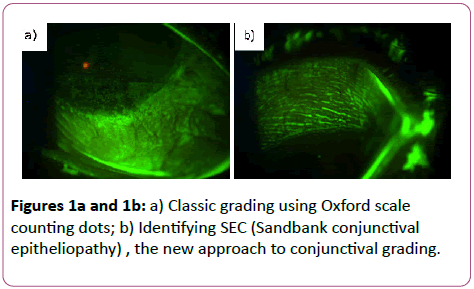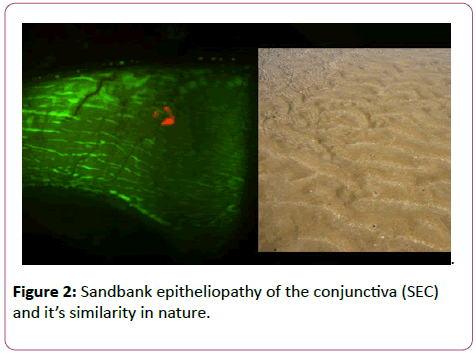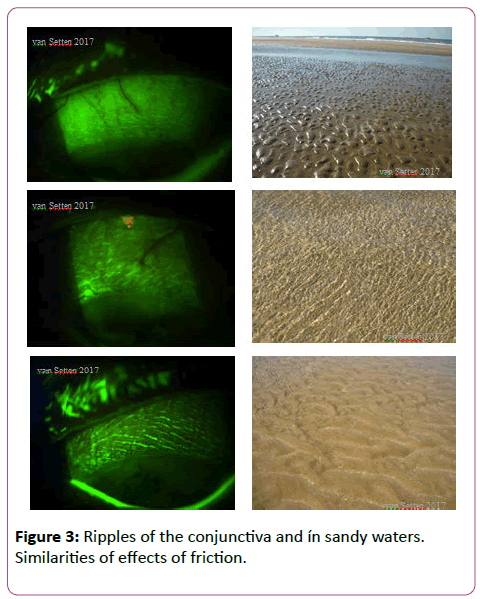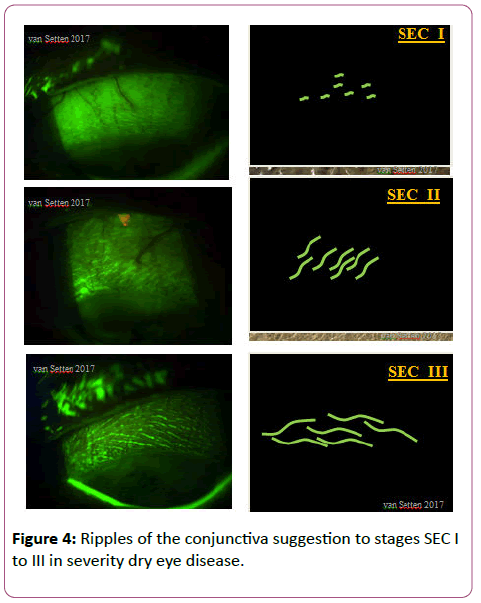Gysbert van Setten*
Department of Clinical Neuroscience, Karolinska Institutet, St Eriks Eye Hospital, Sweden
- *Corresponding Author:
- Gysbert van Setten
Department of Clinical Neuroscience, Karolinska Institutet
St Eriks Eye Hospital, Sweden
Tel: 0046736504963
E-mail: gysbert-botho.vansetten@sll.se
Received date: April 25, 2017; Accepted date: May 22, 2017; Published date: May 31, 2017
Citation: Van Setten G (2017) Sandbank Epitheliopathy of the Conjunctiva (SEC) A New Indicator in Dry Eye Diagnostics Useful for Optimized Ocular Surgery. J Eye Cataract Surg 3:29. doi: 10.21767/2471-8300.100029
Copyright: © 2017 Van Setten G. This is an open-access article distributed under the terms of the Creative Commons Attribution License, which permits unrestricted use, distribution, and reproduction in any medium, provided the original author and source are credited.
Introduction: Increasing awareness of the importance of dry eye disease for the outcome of ocular surgery does emphasize the need for facilitated diagnostic of the ocular surface condition. Currently, corneal fluorescein staining is usually evaluated using the modified Oxford scale in which conjunctival staining is of minor importance and, based on the counting of dots, difficult to assess. We searched an alternative, easily accessible rating option to evaluate conjunctival changes associated with dry eye disease.
Methods: Using standard fluorescein staining, cobalt blue light, and yellow filter we investigated routinely the conjunctiva of patients over 6 months. The specific staining of the conjunctiva was documented digitally 0-30 seconds after instillation of the dye. The staining pattern of patients with dry eye was analyzed.
Results: A clearly distinct change of conjunctival staining on the bulbar conjunctiva was observed in eyes with tear film insufficiency. This sign is easily visible by the use of blue light with a yellow barrier filter. The sign is termed sandbank epitheliopathy of the conjunctiva (SEC). Its’ anatomical correlate are ripples of the conjunctiva that, clearly stained with Fluoresceine, do increase with the severity of dry eye. This specific conjunctival staining does vary with the severity of dry eye.
Discussion: A new conjunctival indicator dry eye disease is presented. The pathophysiological processes leading to SEC are outlined. The ease of access to see SEC gives an alternative to the grading conjunctival fluorescein staining with the Oxford scale. The SEC scale ranges from 0 to 3. The presence of conjunctival stress due to increased friction at the ocular surface does begin at SEC grade I. A practical guide with case illustrations is presented leading to a preliminary grading scale. Conclusion: Sandbank epitheliopathy of the conjunctiva (SEC) can be identified in patients with dry eye disease. As soon as SEC is clearly visible on the conjunctiva, pre- and postoperative treatment with tear fluid modifying agents such as gels or high molecular weight tear fluid substitutes or tear fluid additives is encouraged in order to minimize their potential negative impact on the surgical result.
Keywords
Fluoresceine; Staining; Dry eye disease; Surgery; Conjunctiva
Introduction
The use of vital staining with different dyes is a standard procedure in ophthalmology for the evaluation of ocular surface integrity and health. Especially in the evaluation of dry eye disease and damages on the surface the staining with dyes plays an important role for diagnosis and treatment. Confirmed by the report of DEWS [1], the literature does support the use of especially fluorescein staining for grading and investigating dry eye disease. Even latest publications such as the algorithm for the diagnosis of severe dry eye disease does use corneal fluorescein staining as key indicator for the severity of ocular surface damage [2]. As a very practical tool guidelines that give orientation for grading of severity often the Oxford scale is used [3,4]. Accordingly, it has received wide recognition and is used by many. Even this technique, however, does focus mainly on the visible surface of the eye exposed to the environment. (Figure 1a), although the cornea is covered to full extend, the conjunctival surface is only judged in the visible area medially and temporally the cornea. Here cornea and conjunctival damage is identified by the presence of countable dots where their number is considered equivalent to disease severity. This is on the conjunctiva not an easy task. Similarly to evaluations of staining with fluorescein also other dyes mainly focus on the exposed areas of the lid cleft [5]. Other dyes such as Rose Bengal [6] formerly used for the staining of both cornea and conjunctiva have been replaced by the use of lissamene green [7]. Since years, there is evidence, however, that these clinical signs do not match the symptoms [8]. Considering the subjective symptoms, it is not only the cornea but also the conjunctiva that is very sensitive to traction forces and friction. Here, it could well be, that initial signs of dry eye disease are found rather underneath the lids than on the cornea. It is here, where the major surface of the bulbar conjunctiva is in close contact with the palpebral conjunctiva covering the lids from the inside. Due to the movement of the eye and the movement of the lids the demand on superior lubrication in this narrow space is evident. If clinical signs do occur in association with decreased lubrication, it is the area of the bulbar conjunctiva that could disclose such changes most easily. This has this far not been done. In order to verify this theory we investigated the fluorescein staining of the bulbar conjunctiva in patients with dry eye disease.
Figures 1a and 1b: a) Classic grading using Oxford scale counting dots; b) Identifying SEC (Sandbank conjunctival epitheliopathy) , the new approach to conjunctival grading.
Methods
During routine examination patients with dry eye disease of various degrees and patients prior to cataract surgery were evaluated for the fluorescein staining of the bulbar conjunctiva. Age and gender was not subject of this study. All investigations were performed with a slit lamp using a fluorescein (narrowband blue exciter filter and yellow Kodak Wratten 12 barrier filter as described by Bron et al. [3]. All staining’s were performed using a standardized procedure. Here a 0.5% fluorescein solution without any additives was applied with micropipettes 5 μl of in the lower meniscus of the eye. All photographs were taken within the first 30 seconds after application of the drop containing fluorescein, allowing the best possible staining pattern. All investigations were part of the routine examination procedure for dry eye disease. The regulations of the Declaration of Helsinki were respected.
Results
In all patients fluorescein staining could be observed, both with some punctate staining that could also be used for the Oxford scale (Figure 1a) but also at the a special pattern of fluorescein staining on the bulbar conjunctiva of patients with tear fluid deficiency. A clearly distinct change of conjunctival staining was observed in eyes with tear film insufficiency (Figure 1b). The analogy to the patterns in water is striking (Figure 2) and hence this sign is termed sandbank epitheliopathy of the conjunctiva (SEC).
Figure 2: Sandbank epitheliopathy of the conjunctiva (SEC) and it’s similarity in nature.
The anatomical correlate of sandbank epitheliopathy of the conjunctiva (SEC) are ripple like staining pattern of the conjunctiva that do increase with the severity of dry eye .In the healthy eye this ripple-pattern is not visible. In a minor degree of increased friction the first line segments occur, which however are rather short (>1 mm) and not continuous. This is determed as sandbank epitheliopathy of the conjunctiva (SEC) stage I or SEC I. Even if rinsed with balanced salt solution or as equal this staining will not go away easily. It is not an artifact due to trapped fluorescein, caught in the micro-ridges and microvalleys of the conjunctiva. In patients with more intense complaint the edges of the short line segments begin to merge and to form longer line sections (1-3 mm). This is determed as sandbank epitheliopathy of the conjunctiva (SEC) stage II or SEC II. Then in patients with severe dry eye, often with a longer history of intense complaints, we could see the highest form of expression of conjunctival staining in which the lines are continuous over a few mm (>3 mm) and more intense. This is determed as sandbank epitheliopathy of the conjunctiva (SEC) stage III or SEC III. All these changes are made easily visible using cobalt blue light in combination with a yellow filter. A practical guide with case illustrations is presented leading to a preliminary grading scale (Figures 3 and 4).
Figure 3: Ripples of the conjunctiva and ín sandy waters. Similarities of effects of friction.
Figure 4: Ripples of the conjunctiva suggestion to stages SEC I to III in severity dry eye disease.
The observation that fluorescein does by times cause patterns of staining on the conjunctival surface is not new. As early as in 1990 Eliason and Maurice reported the occurrence of lines and patches of the conjunctiva. These were found remain constant over a long period but later on not further evaluated. Increased fluorescence at folds within the conjunctiva was judged to be principally due to increased thickness of the fluorescein layer in these areas compared with the surrounding region. They have this far not been associated with ocular surface disease. Instead, it has been observed that with increasing severity of dry eye disease special change does occur on the conjunctiva. The use of an efficient pair of excitation and barrier filters leads to a considerable increase in contrast of the dye and allows conjunctival lesions to be identified [9]. Using this technique, punctate staining was already earlier quantified by the grading scheme described by van Bijsterveld [6] using four areas: cornea, and nasal, temporal and inferior conjunctiva. Similar as on the cornea, fluorescein take up, i.e. staining does occur also in the conjunctiva. As a very practical tool guidelines orientation for such severity grading the Oxford scale [3,4] has received wide recognition and is used by many. Still, in today’s approach, conjunctival health is judged by the recognition and counting of punctate staining spots over the conjunctiva with fluorescein; similar to corneal staining with or without the use of a barrier filters [3].
This study shades doubt on this concept and does add the need to evaluate also the pattern of conjunctival staining in order to understand conjunctival health. As evidenced by the presented results, it appears that punctate staining is only the first step towards conjunctival pathology assessment associated with dry eye. The conjunctival lines as described by Eliason and Maurice (1990) are not usually present in the healthy conjunctiva of the young. As this study shows, they do not only possibly correspond to folds in the conjunctiva as suggested earlier. Instead the visibility and the location of these lines as well as their continuity, i.e. longer lines or shorter lines, vary between individuals and remained constant over a long period of observation. They do not go directly away by simply flushing the surface. They remain clearly visible even after washing with application of NaCl physiological solution or BSS, hence are not only a pooling effect. It is hence concluded that these lines may identify epithelial stress lines indicating areas of confluent minor lesions of the conjunctival surface. In analogy to the physical of phenomen observed of the interface between water and sand in which turbulence and friction are major actors, also surface anomalies are formed.
Even though microscopic, the surface changes may initially be only visible as localized punctate staining. However, with time, prolonged and enhanced friction they may aggregate to lines and cause visible changes. In localized areas of surface lesions, lubrication deficiency may lead to localized epithelial damage, evidenced by uptake of some dye such as fluorescein. These fluorescein stained lines most likely are lines of epithelial surface damage and with this outline areas exposed to enhanced stress and friction when the lidis moving above this surface. Increased friction, in turn could result in the same phenomena as reported by the physicist Hertha Ayrton (1910) [10]. In nature we find the same lines or ripples for example in sandy waters. It is due to this analogy the here presented staining pattern is named Sandbank Epitheliopathy of the Conjunctiva (SEC). Although a simple grading has been her suggested according to the appearance of the ripples further studies are needed to optimize and facilitate the use of this indicator. It will be shown if there is additional option and clinical relevance to look at the density of the ripples, their geometry, density etc during different phases or groups of dry eye diseases. It remains to be clarified to which parameters of current tear fluid/dry eye diagnostics the SEC is correlated with. Specific studies to this subject have been initiated.
In contrast to the genesis of these ripples in water and sand, basic forces as outlined by Allen 1969 [11] are slightly different in the eye. Although fluid flow, i.e. basic flow, and with this transverse regions of flow separation, i.e. corkscrew vortices parallel to flow that resemble Taylor-Görtler vortices possibly exist, it must be remembered that the driving force in the origin of the ripples of the conjunctiva is not of centrifugal origin suggested for water and sand [12], but more of mechanical or in that is caused by lid and eye movement. The development of ripples as well as SEC is a result if friction. This is a highly natural phenomenon.
As the conjunctiva is an elastic tissue no direct analogies may be drawn to the detailed knowledge about ripple concentration and forms [11] in interfaces such as water and sand. However the similarities are striking (Figure 4). Although the temperatures are considered rather stable exposure to extremer temperature could, similar to physical fluids could increase friction leading enhanced expression of ripples. This could fit in the concept of psychrometry in dry eye disease [13].
The SEC is also a valuable asset in the pre-operative determination of ocular surface condition, especially prior to performing surgery. Perioperative changes of the surface have en described already by Norn [14]. Although there is increasing awareness of postoperative dry eye syndrome [15] the preoperative evaluation is still not sufficiently standardized in order to establish successful preoperative treatment of tear fluid insufficiencies prior to surgery both in cataract [15], glaucoma and laser surgery. Preoperative surface alterations will enhance the likelihood of postoperative dry eye complaints and changes when they combine with peri-operatively introduced known DED triggering factors such as mechanical forces aging, thermic and phototoxic effects and chemical toxicity of glaucoma treatment [16-20].
Conclusion
Fluoresceine stained lines of the conjunctiva are not just and only an accidental finding. They are not just lines without any pathophysiological relevance. They are signs of enhanced friction, i.e. of a lubrication deficit. Using the suggested identification of various degrees of sandbank epitheliopathy of the conjunctiva (SEC) may become a valuable and easy asset in the diagnosis and stageing of dry eye disease. It is recommended to add the detection of SE to the Minimally Invasive Tests suggested by [3] using fluorescein. The evaluation is easily performed along with BUT, i.e. the Fluorescein tear breakup, and the coordinated grading staining after fluorescein instillation according to the Oxford scheme, the assessment of the meniscus profile and estimation of tear turnover. As SEC evaluation gives a good idea about the friction between inner surface of the lids and the surface of the conjunctiva already pre-operatively precautionary treatment with lubricants such as gels can be initiated favouring an optimized postoperative healing phase by minimizing additional ocular surface stress and friction.
Acknowledgements
The author is very thankful to the Karolinska Institute, Stockholm, Sweden for supporting publication with funds for Research, Development and Education (FoUU).
References
- DEWS (2007) Research in Dry Eye Report of the Research Subcommittee of the International Dry Eye Work Shop. Ocul Surf 5: 179-193.
- Baudouin C, Aragona P, Van Setten G, Rolando M, Irkeç M, et al. ODISSEY European Consensus Group members ( 2014 ) Diagnosing the severity of dry eye: a clear and practical algorithm. Br J Ophthalmol 98: 1168-76.
- Bron A (1997) Reflections on the tears. A discourse on the classification, diagnosis and management of dry eye. The Doyne Lecture. Eye 11: 583-602.
- Bron AJ, Evans VE, Smith JA (2003) Grading Of Corneal and Conjunctival Staining in the Context of Other Dry Eye Tests. Cornea 22: 640-650.
- Alex A, Edwards A, Hays JD, Kerkstrac M, Shih A, de Paiva CS, Pflugfelder SC (2013) Factors predicting the ocular surface response to desiccating environmental stress. Invest Ophthalmol Vis Sci 54: 3325-3332.
- Van Bijsterveld OP (1969) Diagnostic tests in the Sicca Syndrome. Arch Ophthalmol 82: 10-4.
- Norn MS (1973) Lissamine Green Vital Staining of Cornea and Conjunctiva. Acta Ophthalmol (Copenh) 51: 483-491.
- Bartlett JD, Keith MS, Sudharshan L, Snedecor SJ (2015) Associations between signs and symptoms of dry eye disease: a systematic review. Clin Ophthalmol 9: 1719-1730.
- Eliason JA, Maurice DM (1990) Staining of the Conjunctiva and Conjunctival Tear Film. Br J Ophthalmol 74: 519-522.
- Ayrton H (1910) The Origin and Growth of Ripple mark. Proceedings of the Royal Society of London A 84: 285-307.
- Allen JRL (1969) On the Geometry of Current Ripples in Relation to Stability of Fluid Flow Geografiska Annaler. Series A, Physical Geography 51: 61-96.
- Chang FFM (1970) Ripple Concentration and Friction Factor. J Hydraul Div 96: 417-430.
- van Setten G, Labetoulle M, Baudouin C, Rolando M (2016) Evidence of seasonality and effects of psychrometry in dry eye disease. Acta Ophthalmol. 94:499-506
- Norn MS (1981) Per-operative Protection of Cornea and Conjunctiva. Acta Ophthalmol (Copenh) 9: 587-594.
- Miyake K, Yokoi N (2017) Influence on Ocular Surface after Cataract Surgery and Effect of Topical Diquafosol on Postoperative Dry Eye: A Multicenter Prospective Randomized Study. Clin Ophthalmol 11: 529-540.
- Nakamori K, Odawara M, Nakajima T, Mizutani T, Tsubota K (1997) Blinking is Controlled Primarily by Ocular Surface Conditions. Am J Ophthalmol 124: 24-30.
- Mathers WD, Lane JA, Zimmerman MB (1996) Tear Film Changes Associated with Normal Aging. Cornea 15:229-234.
- Paschides CA, Stefaniotou M, Papageorgiou J, Skourtis P, Psilas K (1998) Ocular Surface and Environmental Changes. Acta Ophthalmol Scand 76:74-77.
- Cho YK, Kim MS (2009) Dry Eye after Cataract Surgery and Associated Intraoperative Risk Factors. Korean J Ophthalmol 23: 65-73.
- Pisella PJ, Pouliquen P, Baudouin C (2002) Prevalence of Ocular Symptoms And Signs with Preserved and Preservative Free Glaucoma Medication. Br J Ophthalmol 86: 418-423.





